Ceramic magnets are the lowest cost hard permanent magnets available today. They are made from a combination of iron oxide and strontium carbonate, which is why they are also known as ferrite magnets. Read more about how ceramic magnets are made.
Key characteristics of ceramic permanent magnets include excellent magnetization abilities, demagnetization resistance, and corrosion resistance, good magnetic strength, and fair high-temperature resistance. These qualities have led to them becoming the top pick for many magnetic technologies, including automobile sensors, DC motors, and MRI machines.
We stock a variety of sizes and shapes in ceramic grades 1, 5, and 8. However, we can also produce other configurations for specific customer requirements. For a comparison of ceramic grades 5 and 8, please see our Chart of Properties.
Benefits of Ceramic Magnets
Approximately 75% of all magnets produced and used around the world are ceramic magnets. There are many reasons for this popularity. For example:
- They are less expensive than other magnets (e.g., rare earth magnets).
- They are naturally corrosion-resistant.
- They are easy to magnetize and hard to demagnetize.
- They can be magnetized with multiple poles.
Ceramic Magnets Stock Selection
Adams offers a wide selection of Ceramic magnet products. Click on your desired product type for stock product specifications.
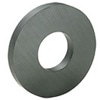
Ceramic Ring Magnets
Our stock ceramic ring magnets are Grade 5, magnetized through the thickness.
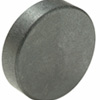
Ceramic Discs
View a small sampling of our stock ceramic disc magnets in Grades 1, 5 or 8.
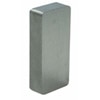
Ceramic Rectangles
We stock ceramic bar magnets in Grade 5, magnetized through the thickness.
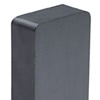
Ceramic Block Magnets
We stock ceramic block magnets in Grade 8, magnetized through the thickness.
Our Custom Ceramic Magnet Capabilities
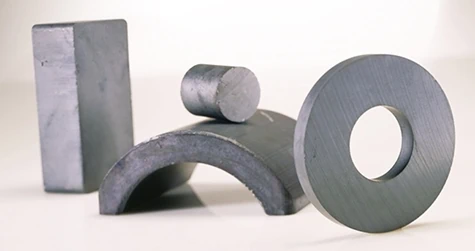 Some considerations to keep in mind when purchasing ceramic magnets include:
Some considerations to keep in mind when purchasing ceramic magnets include:- Machining. Machining must be performed with a diamond wheel, preferably before magnetization. Ceramic magnets are chemically inert non-conductors, which is a benefit in many applications but eliminates the use of the EDM process to produce samples or special shapes.
- Tolerances. We can cut and grind standard sizes to meet the necessary specifications and standards. Standard tolerances are +/-.005 inches for ground dimensions and +/- 2% of feature size for sintered dimensions.
- Brittleness. Due to their brittle nature, ceramic magnets will not withstand impact or flexing. They are also not recommended to be used as structural components in assemblies.
- Application temperature conditions. Due to ceramic’s positive temperature coefficient of Hci, high temperatures are not generally a major concern with respect to irreversible magnetic loss. Low temperatures, however, pose a much greater risk for permanent demagnetization. For example, a ceramic 5 grade with a permeance coefficient of 1 will start to experience permanent losses below -20° C.
- Magnetization and magnetic properties. Isotropic ceramic grades can be magnetized in any direction, while anisotropic grades have a preferred direction of magnetization and will only meet their full magnetic potential when magnetized along the “easy axis.”
Why Buy Ceramic Magnets from Adams Magnetic Products?
For ceramic magnets you can trust in your most critical products and processes, turn to the magnet experts at Adams Magnetic Products. By partnering with us, you benefit from our:
- A broad selection of standard magnet products
- Extensive custom magnet capabilities
- ISO 9001:2015 certification
- ITAR registration
Our team is committed to delivering a magnet solution that fully meets your needs. We can support your ideas with:
Magnetic Modeling
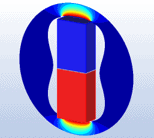
Magnet Fastening

Value-Added Assemblies
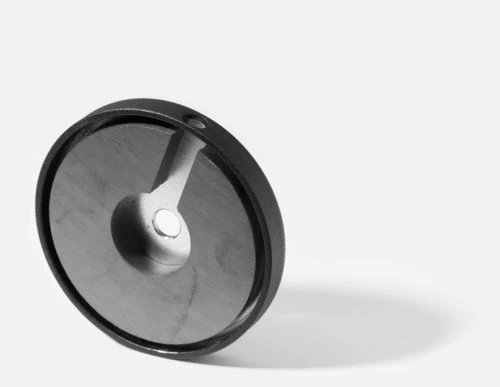
Online Tools
We can help calculate magnetic field strength (measured in Gauss) on the centerline of a disc magnet or ring magnet magnetized through its thickness at a distance of X from the surface of the magnet. To get started, check out our Gauss and Pull calculators.
To learn more about ceramic magnets, visit our ceramic magnets resource library. To get started on choosing a magnet product for your application, request a quote.
Types of Ferrite (Ceramic) Magnets

1. Hard ceramic magnets have a high coercivity level, meaning their magnetic properties are difficult to alter. This quality makes them well-suited for applications that require a high-strength permanent magnet. At Adams Magnetic Products, we offer the following types of hard ceramic magnets:
- Ceramic ring magnets: These magnets are typically used in craft, hobby, and manufacturing projects.
- Ceramic disk magnets: These magnets can be magnetized with multiple poles on one face to achieve greater holding strength on that surface. Typical applications include craft, hobby, and manufacturing projects.
- Ceramic rectangle magnets: These magnets are commonly used in simple applications (e.g., crafts, latches, and toys) and technical applications (e.g., actuating and sensing).
- Ceramic block magnets: These magnets are used in holding, separating, sweeping, and many other applications.
2. Soft ferrite cores have a low coercivity level, meaning their magnetic properties (e.g., the position of their poles) are easy to change. This quality makes them ideal for use in electrical conductors and other similar applications. Adams stopped offering soft ferrite in September 2014. Read more.
How Are Ceramic Magnets Made?
Ceramic magnets are manufactured using powder technologies and techniques. Iron oxide and strontium carbonate are combined and heated to 1,800–2,000° F. At these high temperatures, the compounds undergo a chemical reaction that produces ferrite. The resulting material is subjected to a wet milling process, which reduces it to a smaller particle size. The milled powder can then be processed into one of two forms for use in magnetic product production: dry (for dry pressed products) or wet slurry (for die injected products).



